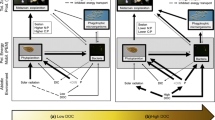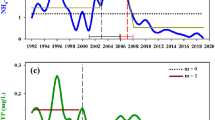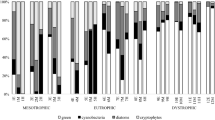Abstract
The amount of terrestrial particulate organic matter (t-POM) entering lakes is predicted to increase as a result of climate change. This may especially alter the structure and functioning of ecosystems in small, shallow lakes which can rapidly shift from a clear-water, macrophyte-dominated into a turbid, phytoplankton-dominated state. We used the integrative ecosystem model PCLake to predict how rising t-POM inputs affect the resilience of the clear-water state. PCLake links a pelagic and benthic food chain with abiotic components by a number of direct and indirect effects. We focused on three pathways (zoobenthos, zooplankton, light availability) by which elevated t-POM inputs (with and without additional nutrients) may modify the critical nutrient loading thresholds at which a clear-water lake becomes turbid and vice versa. Our model results show that (1) increased zoobenthos biomass due to the enhanced food availability results in more benthivorous fish which reduce light availability due to bioturbation, (2) zooplankton biomass does not change, but suspended t-POM reduces the consumption of autochthonous particulate organic matter which increases the turbidity, and (3) the suspended t-POM reduces the light availability for submerged macrophytes. Therefore, light availability is the key process that is indirectly or directly changed by t-POM input. This strikingly resembles the deteriorating effect of terrestrial dissolved organic matter on the light climate of lakes. In all scenarios, the resilience of the clear-water state is reduced thus making the turbid state more likely at a given nutrient loading. Therefore, our study suggests that rising t-POM input can add to the effects of climate warming making reductions in nutrient loadings even more urgent.




Similar content being viewed by others
References
Adamek Z, Marsalek B. 2013. Bioturbation of sediments by benthic macroinvertebrates and fish and its implication for pond ecosystems: a review. Aquacult Int 21:1–17.
Aldenberg T, Janse JH, Kramer PRG. 1995. Fitting the dynamic-model PCLake to a multi-lake survey through Bayesian statistics. Ecol Model 78:83–99.
Amthor JS. 1995. Terrestrial higher-plant response to increasing atmospheric [CO2] in relation to the global carbon-cycle. Glob Change Biol 1:243–74.
Ask J, Karlsson J, Persson L, Ask P, Bystrom P, Jansson M. 2009. Terrestrial organic matter and light penetration: effects on bacterial and primary production in lakes. Limnol Oceanogr 54:2034–40.
Attermeyer K, Premke K, Hornick T, Hilt S, Grossart HP. 2013. Ecosystem-level studies of terrestrial carbon reveal contrasting bacterial metabolism in different aquatic habitats. Ecology 94(12):2754–66.
Bartels P, Cucherousset J, Gudasz C, Jansson M, Karlsson J, Persson L, Premke K, Rubach A, Steger K, Tranvik LJ, Eklov P. 2012a. Terrestrial subsidies to lake food webs: an experimental approach. Oecologia 168:807–18.
Bartels P, Cucherousset J, Steger K, Eklov P, Tranvik LJ, Hillebrand H. 2012b. Reciprocal subsidies between freshwater and terrestrial ecosystems structure consumer resource dynamics. Ecology 93:1173–82.
Breukelaar AW, Lammens EHRR, Breteler JGPK, Tatrai I. 1994. Effects of benthivorous bream (Abramis brama) and carp (Cyprinus carpio) on sediment resuspension and concentrations of nutrients and chlorophyll-a. Freshw Biol 32:113–21.
Carpenter SR, Cole JJ, Kitchell JF, Pace ML. 1998. Impact of dissolved organic carbon, phosphorus, and grazing on phytoplankton biomass and production in experimental lakes. Limnol Oceanogr 43:73–80.
Carpenter SR, Cole JJ, Pace ML, Van de Bogert M, Bade DL, Bastviken D, Gille CM, Hodgson JR, Kitchell JF, Kritzberg ES. 2005. Ecosystem subsidies: terrestrial support of aquatic food webs from C-13 addition to contrasting lakes. Ecology 86:2737–50.
Cole JJ, Carpenter SR, Pace ML, Van de Bogert MC, Kitchell JL, Hodgson JR. 2006. Differential support of lake food webs by three types of terrestrial organic carbon. Ecol Lett 9:558–68.
Dillon PJ, Molot LA. 1997. Dissolved organic and inorganic carbon mass balances in central Ontario lakes. Biogeochemistry 36:29–42.
Dixon KR. 1976. Analysis of seasonal leaf fall in north temperate deciduous forests. Oikos 27:300–6.
Downing JA, Prairie YT, Cole JJ, Duarte CM, Tranvik LJ, Striegl RG, McDowell WH, Kortelainen P, Caraco NF, Melack JM, Middelburg JJ. 2006. The global abundance and size distribution of lakes, ponds, and impoundments. Limnol Oceanogr 51:2388–97.
Foley JA, DeFries R, Asner GP, Barford C, Bonan G, Carpenter SR, Chapin FS, Coe MT, Daily GC, Gibbs HK, Helkowski JH, Holloway T, Howard EA, Kucharik CJ, Monfreda C, Patz JA, Prentice IC, Ramankutty N, Snyder PK. 2005. Global consequences of land use. Science 309:570–4.
Forsström L, Roiha T, Rautio M. 2013. Responses of microbial food web to increased allochthonous DOM in an oligotrophic subarctic lake. Aquat Microb Ecol 68:171–84.
Fragoso CR, Marques DMLM, Ferreira TF, Janse JH, van Nes EH. 2011. Potential effects of climate change and eutrophication on a large subtropical shallow lake. Environ Model Softw 26:1337–48.
France RL, Peters RH. 1995. Predictive model of the effects on lake metabolism of decreased airborne litterfall through riparian deforestation. Conserv Biol 9:1578–86.
Francis TB, Schindler DE, Holtgrieve GW, Larson ER, Scheuerell MD, Semmens BX, Ward EJ. 2011. Habitat structure determines resource use by zooplankton in temperate lakes. Ecol Lett 14:364–72.
Grey J, Jones RI, Sleep D. 2001. Seasonal changes in the importance of the source of organic matter to the diet of zooplankton in Loch Ness, as indicated by stable isotope analysis. Limnol Oceanogr 46:505–13.
Gulati RD, Siewertsen K, Postema G. 1982. The zooplankton: its community structure, food and feeding, and role in the ecosystem of Lake Vechten. Hydrobiologia 95:127–63.
Gunderson LH. 2000. Ecological resilience—in theory and application. Annu Rev Ecol Syst 31:425–39.
Houser JN. 2006. Water color affects the stratification, surface temperature, heat content, and mean epilimnetic irradiance of small lakes. Can J Fish Aquat Sci 63:2447–55.
Houser JN, Bade DL, Cole JJ, Pace ML. 2003. The dual influences of dissolved organic carbon on hypolimnetic metabolism: organic substrate and photosynthetic reduction. Biogeochemistry 64:247–69.
Janse JH. 1997. A model of nutrient dynamics in shallow lakes in relation to multiple stable states. Hydrobiologia 342:1–8.
Janse JH. 2005. Model studies on the eutrophication of shallow lakes and ditches. Wageningen: Wageningen University.
Janse JH, Aldenberg T, Kramer PRG. 1992. A mathematical-model of the phosphorus cycle in Lake Loosdrecht and simulation of additional measures. Hydrobiologia 233:119–36.
Janse JH, Van Donk E, Gulati R. 1995. Modelling nutrient cycles in relation to food web structure in a biomanipulated shallow lake. Neth J Aquat Ecol 29:67–79.
Janse JH, De Senerpont Domis LN, Scheffer M, Lijklema L, Van Liere L, Klinge M, Mooij WM. 2008. Critical phosphorus loading of different types of shallow lakes and the consequences for management estimated with the ecosystem model PCLake. Limnologica 38:203–19.
Janse JH, Scheffer M, Lijklema L, Van Liere L, Sloot JS, Mooij WM. 2010. Estimating the critical phosphorus loading of shallow lakes with the ecosystem model PCLake: sensitivity, calibration and uncertainty. Ecol Model 221:654–65.
Jeppesen E, Jensen JP, Sondergaard M, Lauridsen T, Landkildehus F. 2000. Trophic structure, species richness and biodiversity in Danish lakes: changes along a phosphorus gradient. Freshw Biol 45:201–18.
Jones RI. 1992. The influence of humic substances on lacustrine planktonic food-chains. Hydrobiologia 229:73–91.
Jones JI, Sayer CD. 2003. Does the fish–invertebrate–periphyton cascade precipitate plant loss in shallow lakes? Ecology 84:2155–67.
Jones RI, Grey J, Sleep D, Quarmby C. 1998. An assessment, using stable isotopes, of the importance of allochthonous organic carbon sources to the pelagic food web in Loch Ness. Proc R Soc B 265:105–11.
Jones SE, Solomon CT, Weidel BC. 2012. Subsidy or substraction: how do terrestrial inputs influence consumer production in lakes? Freshw Rev 5:37–49.
Karlsson J, Bystrom P, Ask J, Ask P, Persson L, Jansson M. 2009. Light limitation of nutrient-poor lake ecosystems. Nature 460:506–509.
Marczak LB, Thompson RM, Richardson JS. 2007. Meta-analysis: trophic level, habitat, and productivity shape the food web effects of resource subsidies. Ecology 88:140–8.
McKnight DM, Aiken GA. 1998. Sources and age of aquatic humus. In: Hessen DO, Tranvik LJ, Eds. Aquatic humic substances: ecology and Biogeochemistry. Berlin: Springer. p 259–83.
Mooij WM, Janse JH, De Senerpont Domis LN, Hulsmann S, Ibelings BW. 2007. Predicting the effect of climate change on temperate shallow lakes with the ecosystem model PCLake. Hydrobiologia 584:443–54.
Mooij WM, De Senerpont Domis LN, Janse JH. 2009. Linking species- and ecosystem-level impacts of climate change in lakes with a complex and a minimal model. Ecol Model 220:3011–20.
Mooij WM, Trolle D, Jeppesen E, Arhonditsis G, Belolipetsky PV, Chitamwebwa DBR, Degermendzhy AG, DeAngelis DL, De Senerpont Domis LN, Downing AS, Elliott JA, Fragoso CR, Gaedke U, Genova SN, Gulati RD, Hakanson L, Hamilton DP, Hipsey MR, ‘t Hoen J, Hülsmann S, Los FH, Makler-Pick V, Petzoldt T, Prokopkin IG, Rinke K, Schep SA, Tominaga K, Van Dam AA, van Nes EH, Wells SA, Janse JH. 2010. Challenges and opportunities for integrating lake ecosystem modelling approaches. Aquat Ecol 44:633–67.
Ostrofsky ML. 1997. Relationship between chemical characteristics of autumn-shed leaves and aquatic processing rates. J N Am Benthol Soc 16:750–9.
Pace ML, Cole JJ. 2002. Synchronous variation of dissolved organic carbon and color in lakes. Limnol Oceanogr 47:333–42.
Sand-Jensen K, Madsen TV. 1991. Minimum light requirements of submerged freshwater macrophytes in laboratory growth experiments. J Ecol 79:749–64.
Scharnweber K. 2013. The effects of structural complexity on ecological and evolutionary processes in shallow lake ecosystems. Berlin: Freie Universität Berlin.
Scharnweber K, Syväranta J, Hilt S, Brauns M, Vanni MJ, Brothers S, Köhler J, Knezevic-Jaric J, Mehner T. 2014. Whole-lake experiments reveal the fate of terrestrial particulate organic carbon in benthic food webs of shallow lakes. Ecology. doi:10.1890/13-0390.1.
Scheffer M, Beets J. 1994. Ecological models and the pitfalls of causality. Hydrobiologia 275(276):115–24.
Scheffer M, Jeppesen E. 2007. Regime shifts in shallow lakes. Ecosystems 10:1–3.
Scheffer M, Hosper SH, Meijer ML, Moss B, Jeppesen E. 1993. Alternative equilibria in shallow lakes. Trends Ecol Evol 8:275–9.
Sollie S, Janse JH, Mooij WM, Coops H, Verhoeven JTA. 2008. The contribution of marsh zones to water quality in Dutch shallow lakes: a modeling study. Environ Manag 42:1002–16.
Solomon CT, Carpenter SR, Clayton MK, Cole JJ, Coloso JJ, Pace ML, Vander Zanden MJ, Weidel BC. 2011. Terrestrial, benthic, and pelagic resource use in lakes: results from a three-isotope Bayesian mixing model. Ecology 92:1115–25.
Steinberg CEW, Kamara S, Prokhotskaya VY, Manusadzianas L, Karasyova TA, Timofeyev MA, Jie Z, Paul A, Meinelt T, Farjalla VF, Matsuo AYO, Burnison BK, Menzel R. 2006. Dissolved humic substances—ecological driving forces from the individual to the ecosystem level? Freshw Biol 51:1189–210.
ter Heerdt G, Schep S, Janse J, Ouboter M. 2007. Climate change and the EU Water Framework Directive: how to deal with indirect effects of changes in hydrology on water quality and ecology? Water Sci Technol 56:19–26.
Tranvik LJ. 1988. Availability of dissolved organic-carbon for planktonic bacteria in oligotrophic lakes of differing humic content. Microb Ecol 16:311–22.
van Nes EH, Scheffer M. 2005. A strategy to improve the contribution of complex simulation models to ecological theory. Ecol Model 185:153–64.
Zaehle S, Bondeau A, Carter T, Cramer W, Erhard M, Prentice I, Reginster I, Rounsevell M, Sitch S, Smith B, Smith P, Sykes M. 2007. Projected changes in terrestrial carbon storage in Europe under climate and land-use change, 1990–2100. Ecosystems 10:380–401.
Acknowledgments
We thank K. Attermeyer, M. Brauns, S. Brothers, P. Casper, H. P. Grossart, M. Kaupenjohann, T. Klauschies, J. Köhler, S. Kosten, M. Lukas, N. Meyer, and K. Scharnweber for useful discussions. This study was financed by the TERRALAC-project (www.TERRALAC.igb-berlin.de) of the Wissenschaftsgemeinschaft Leibniz (WGL). B. Lischke thanks the participants of the workshop “Scientific writing” at the Leibniz-Institute of Freshwater Ecology and Inland Fisheries.
Author information
Authors and Affiliations
Corresponding author
Additional information
Author Contributions
BL: conceived study, performed research, analyzed data, contributed new models, wrote the paper; SH: conceived study, analyzed data, wrote the paper; JHJ: contributed new models and wrote the paper; JJK: performed research, analyzed data, contributed new models, wrote the paper; TM: conceived study, analyzed data, wrote the paper; WMM: performed research, analyzed data, contributed new models, wrote the paper; UG: conceived study, analyzed data, wrote the paper.
Electronic supplementary material
Below is the link to the electronic supplementary material.
Rights and permissions
About this article
Cite this article
Lischke, B., Hilt, S., Janse, J.H. et al. Enhanced Input of Terrestrial Particulate Organic Matter Reduces the Resilience of the Clear-Water State of Shallow Lakes: A Model Study. Ecosystems 17, 616–626 (2014). https://doi.org/10.1007/s10021-014-9747-7
Received:
Accepted:
Published:
Issue Date:
DOI: https://doi.org/10.1007/s10021-014-9747-7




